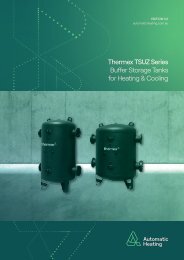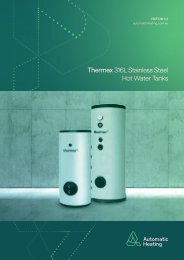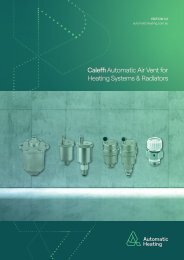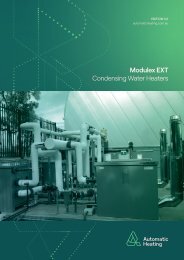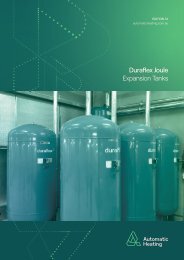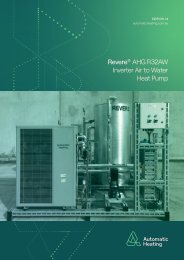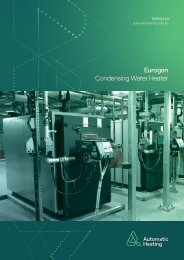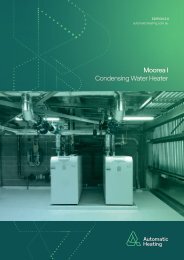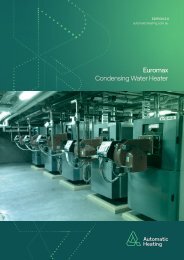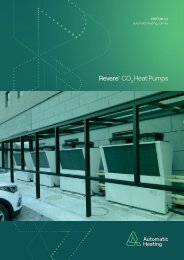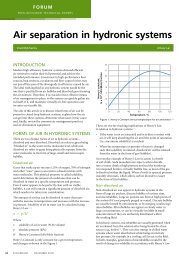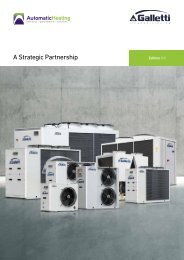AHG Solutions Guide_Edition 2.7
Full Product and Solutions Guide - Automatic Heating Global Pty Ltd
Full Product and Solutions Guide - Automatic Heating Global Pty Ltd
You also want an ePaper? Increase the reach of your titles
YUMPU automatically turns print PDFs into web optimized ePapers that Google loves.
Contents<br />
Dirt and Air Separation<br />
Air<br />
Due to the physical nature of water, it is impossible to<br />
prevent air from becoming trapped in the system.<br />
Air can enter through:<br />
• Filling and makeup water<br />
• System alterations and maintenance<br />
• Open header tanks<br />
• Micro leaks and diffusion through system components<br />
• Henry’s Law - “Gas is a natural constituent of water and<br />
other liquids. The presence and solubility depend on<br />
temperature and pressure within the liquid” (William Henry<br />
(1775 – 1836)<br />
Free Air<br />
Microbubbles<br />
Dissolved Air<br />
Once in the system, gas can be observed in<br />
three different forms<br />
As Henry’s Law describes, the presence and solubility of<br />
gas in a liquid depends on two elements – temperature and<br />
pressure. Whereas a hot water system causes the water to<br />
expand and the gas more easily removed, a chilled water<br />
system results in the water becoming dense and the gas<br />
more soluble.<br />
Similarly, where the system pressure is low, degassing is<br />
more easily achieved. But as the pressure increases, not<br />
only is the presence of gas greater but it also becomes<br />
much more difficult for traditional methods of removal –<br />
such as air vents – to release it.<br />
Free Air<br />
“Free” gas or air is both the most common and most easily<br />
removed, as it has not yet become soluble in the water. It<br />
can be found as air pockets and is typically released via<br />
simple air vents strategically placed around the system.<br />
A Duraflex EcoTop Automatic Air Vent removes free air<br />
quickly, offering continuous, maintenance-free operation<br />
and high reliability.<br />
Microbubbles<br />
Where gas has entered the liquid at some pressure,<br />
microbubbles are often formed. Smaller than one<br />
millimeter in diameter but larger than one micrometer,<br />
these bubbles of gas are created by turbulence in the water<br />
(often where there is a loss of pressure, such as a pumping<br />
pillar) and are commonly in hot water systems.<br />
Although visible to the eye, microbubbles cannot be<br />
removed by air vents as they are carried with the water<br />
stream. Rather, an air separator like a Duraflex EcoVent,<br />
which is suitable for heating systems up to 300 kpa, should<br />
be installed on the flow side of the heat source for effective<br />
deaeration.<br />
By slowing the water down as it passes through the mesh<br />
in the chamber, the microbubbles are broken up and the<br />
gas separates out of the water stream and is vented at the<br />
top of the chamber.<br />
Dissolved Air<br />
But where the pressure is higher and/or the temperature is<br />
low – as is common in chilled water systems – most gases<br />
become totally solubilised in the water.<br />
In much the same way carbon dioxide remains invisible in<br />
a bottle of lemonade until opened, the solubilised gas can<br />
only be removed from the water stream by reducing the<br />
pressure.<br />
A Duraflex Vacuum Deaerator removes dissolved air<br />
quickly, offering continuous operation and high reliability.<br />
EXPANSION &<br />
DEAERATION<br />
191



